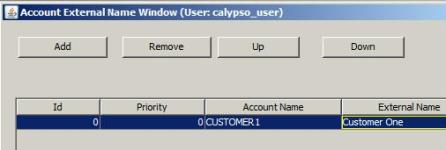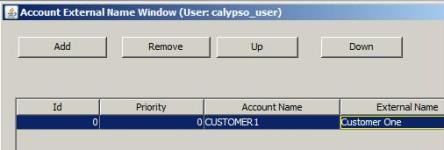Defining Accounts
Accounts are entities where the Accounting engine applies postings. Accounts are generally maintained in a General Ledger system at your organization. As the Accounting engine saves each posting, it labels the posting with an account number. These postings will then be fed into the General Ledger system.
The link between accounting events and accounts will be specified using accounting rules.
 See Call Accounts for information on creating call accounts for client cash management.
See Call Accounts for information on creating call accounts for client cash management.
From the Calypso Navigator, navigate to Configuration
> Accounting > Accounts (menu action refdata.AccountFrame) to define accounts.
1. Creating Accounts
The Account panel is selected by default, it allows creating new accounts.
| » | Click New, and enter the fields described below to create an account. |
| » | Then click Save to save your changes. |
Note that if the Authorization mode is enabled, an authorized user must approve your entry.
You can also click SaveAsNew to create the account as a new account provided you enter a new account name.
| » | You can select the Translation/Revaluation panel to specify the parameters to perform FX Revaluation and FX Translation. |
 See FX Revaluation and FX Translation for details.
See FX Revaluation and FX Translation for details.
|
Fields |
Description |
|||||||||||||||
|
Account Name |
Enter the name of the account that will identify the account throughout the system. The account number can be directly populated by the account name, or can be generated automatically from user-defined attributes. The definition of automatic accounts is described below. |
|||||||||||||||
| Call Account |
The Call Account field only appears if environment property USE_CALL_ACCOUNT = true. When Call Account is selected, a new Legal Entity field is displayed for Client Sender. This field displays options to search Legal Entities with role as 'ClientSender'.
|
|||||||||||||||
|
Custody |
The Custody field should only be used in the context of Security Custody functions.
|
|||||||||||||||
|
Processing Org |
Select the processing organization that holds this account, or ALL. A SETTLE account is restricted to a specific processing organization, unless it is automatic. For automatic SETTLE accounts, you can select AUTO. The account numbers will be automatically created by processing organization. The definition of automatic accounts is described below. |
|||||||||||||||
|
Ccy |
Select the currency of the postings to this account or ANY. A SETTLE account is restricted to a specific currency, unless it is automatic. For automatic SETTLE accounts, you can select AUTO. The account numbers will be automatically created by currency. The definition of automatic accounts is described below. For SETTLE accounts, ANY is not supported. For SETTLE security accounts, the currency is not used. |
|||||||||||||||
|
Id |
Unique id given by the system upon saving. |
|||||||||||||||
|
Type |
Select the type of the account. The following types are associated with specific processes.
Click ... to add new types of account as needed. |
|||||||||||||||
| Subtype |
Only applies to SETTLE accounts. This is currently only used for ETD Clearing.
|
|||||||||||||||
| Security |
This field only appears for SETTLE accounts. Check the Security checkbox to indicate that the account is a security account. |
|||||||||||||||
|
Auto/Template Acc |
Check the “Auto/Template Acc” to create account numbers based on user-defined attributes for this account.
|
|||||||||||||||
|
Orig Acc |
This field only appears when you load an account number that has been automatically generated. It displays the id of the original account definition. |
|||||||||||||||
|
External Name |
Enter an external name as needed. It can be used when exporting postings to the general ledger. You can click
|
|||||||||||||||
|
Interface Rule |
Select the rule for exporting postings on this account to the general ledger:
|
|||||||||||||||
|
Description |
Enter a free field to describe the account. |
|||||||||||||||
|
Legal Entity (F2) |
Optional. Click ... to select the owner of the account. This is mostly used for settlement accounts to identify the agent / customer owning the account. You can also hit F2. |
|||||||||||||||
|
Role |
Select the role of the legal entity that owns the account, if applicable. You can select ALL otherwise. |
|||||||||||||||
| Multi-Owner |
For the Client role, you can define multiple owners in the Legal Entities panel. This only applies to Security Custody.
|
|||||||||||||||
|
Creation Date |
Displays the date when the account was created. |
|||||||||||||||
|
Create by Acc Engine only |
This checkbox only appears for automatic accounts. If checked, the automatic account number will only be generated by the Accounting engine. If not checked, the automatic account number can be generated by both the Accounting engine and the Transfer engine. |
|||||||||||||||
|
Closing Account |
Click ... to select a closing account as applicable.
|
|||||||||||||||
|
Last Closing Date |
This is related to the End of Year Close function. It stores the last closing date.
|
|||||||||||||||
|
Parent Account |
Click ... to select a parent account as applicable. This allows creating account hierarchies. The Account Balance report allows aggregating accounts based on account hierarchies. Help is available from the report. |
|||||||||||||||
|
Parent Id |
Displays the id of the selected parent account. |
|||||||||||||||
|
Balance |
Check the Balance checkbox to specify that the account can generate balances. You will be prompted to define the balance frequency.
If you have selected a weekly or monthly frequency, you can select the day of the week or month in the Day field.
|
2. Defining Automatic Accounts
The account number of automatic accounts is generated automatically from user-defined attributes. For example, an account number can be a combination of constants, trade attributes, etc.
You should create automatic accounts when you can identify a pattern in the chart of accounts. For example, a group of accounts start with 222, then contain the product type and the currency.
Once you have checked the “Auto/Template Acc” checkbox, select the Attributes panel to define the attributes.

| » | Click Add to add a new attribute, and enter the fields described below. |
| – | Order - Enter the order of the attribute. |
| – | Attribute - Select an attribute name, or “Constant” to specify a constant. |
| – | Value - Enter the value for Constant attributes. |
| » | You can also click CopyFrom to copy the attributes from another account, you will be prompted to select an account. |
Under the panel Translation/Revaluation, you can set the parameter "Propagate" to true, to propagate all the account attributes ("Attributes" panel) and properties (Properties/Attributes (f4) button) set on the "parent" account to the automatic accounts generated by the "parent" account.
If you do not want to propagate some of the attributes, you can add them to the domain "accountAutoAttributes.PropagateExclude".
Ⓘ [NOTE: For automatic SETTLE accounts, the processing org must be a specific processing organization or AUTO, and the currency must be a specific currency or AUTO - When you select AUTO, the account numbers will be automatically created by processing org and/or currency based on the selected attributes]
3. Defining Account Properties
Account properties can be used for selection and reporting purposes. They are user-defined.
Load an account and specify account properties as applicable.
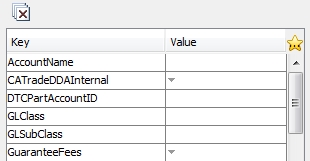
| » | Enter the property value in the Value field. |
If you want to specify a list of possible values for a given property, create the domain “accountProperty.<attribute name>”, and add the values to that domain - The name is case sensitive.
| » | You can click |
When Utilities > Show All Properties is checked all properties are displayed.
When Utilities > Show All Properties is unchecked, only favorite properties are displayed.
| » | You can choose Utilities > Add Property Domain to add new properties. |
4. Defining Settle Accounts
When a SETTLE account is defined, additional functions are available: management fees generation, statements generation, interest generation, sub-accounts, and limit checking.
 See Cash Management for complete details.
See Cash Management for complete details.

4.1 Status and Account Validity Period
| » | Select a status as applicable. Account status codes can be added using Utilities > Add Account Status Domain, Utilities > Add Account Active Status Domain for active accounts, Utilities > Add Account Closed Status Domain for closed accounts, Utilities > Add Account Pending Status Domain for pending accounts, or Utilities > Add Account Suspended Status Domain for suspended accounts. |
| » | Enter the Active From and Active To dates for defining the account’s validity period. Postings can only be back-dated after the Active From date. When an account becomes inactive, you will be prompted to de-activate the SDIs in which the account is used, if any. |
| » | You can check “by Trade Date” to set the effective date to the posting’s trade date. Otherwise, it is the value date. |
4.2 Account Closing Balance Check
To enable the balance check when closing SETTLE accounts, you need to set Comment=true, for the value CHECK_CLOSE_SETTLE_ACCOUNT in the domain “AccountSetup”.

When enabled, it is no longer possible to manually set the Active To date on a SETTLE account, or the status to a status defined in the domains “accountSuspendedStatus” or “accountClosedStatus”.
The closing process in this case, is a two-step process.
Step 1 - You first need to suspend the account using Process > Closure Process > Close from the Account window. You will be prompted to enter the Active To date. It will be set on the account, and the SDIs that use this account. The account status will be set to the status defined in the domain “accountSuspendedStatus”.
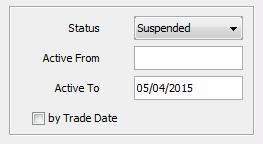
Step 2 - On the Active To date, manually change the account status to the status defined in the domain “accountClosedStatus”.
Upon saving, the system will check that there is no transfer in the future. If any, a Transfer report will be displayed with the future transfers. You may reassign those transfers to different accounts as needed.
The system will check that all inventory positions for this account are zero. The inventory positions to be checked must be added to the domain “InventoryClosurePositions”. If not set, it will check the positions defined in the domain “InventoryPositions”. If any, an Inventory Position report will be displayed with the non-zero positions.
4.3 Retroactivity
| » | Click ... to select a date rule for defining the retroactivity period for Account Sweeps and Interest Scales. |
| – | Account Sweeps: If the Retroactivity field is empty, there is no retroactivity. |
| – | Interest Scales: The Scheduled Task ACCOUNT_INTEREST has an attribute which allows managing retroactivity. If this attribute is set to ‘true’, the system takes into account the Retroactivity date rule on the Account, and if no rule is set-up, the limit is one year. |
4.4 Interest Bearing
Interests can be calculated on settle accounts.
| » | Check the “Interest Bearing” checkbox to allow the calculation of interests. |
| » | Then select the Interests panel to associate interest rules with the account. Interest rules are defined using Process > Interest Bearing > Interest Config Window. |
 See Cash Management - Interest Bearing for complete details.
See Cash Management - Interest Bearing for complete details.
4.5 Billing
Management fees can be calculated on settle accounts.
Check the Billing checkbox to allow the calculation of management fees.
 See Cash Management - Management Fees for complete details.
See Cash Management - Management Fees for complete details.
4.6 Sub-Accounts
A sub-account can be defined with a proprietary account (parent account), and a subtype.
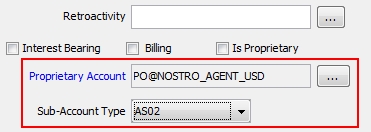
Sub-account types can be defined in the domain "SubAccountType".
A proprietary account is an account defined with "Is Proprietary" checked, and with the same legal entity as the sub-account.
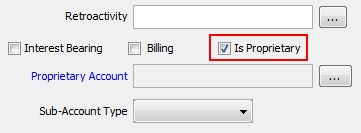
You can select sub-accounts in SDIs in place of the G/L accounts.
You can display sub-accounts in the Transfer Report and the Inventory Position.
4.7 Statements
Select the Statements panel to define statement generation. Statements can be generated on the Back Office position calculated by the Inventory engine.
Note that statements can be created only for accounts that have a processing organization, a currency, and an account owner (legal entity and role must be specified).
 See Cash Management - Account Statement for complete details.
See Cash Management - Account Statement for complete details.
4.8 Limits
Select the Limits panel to define overdraft limits as needed.

| » | Enter a minimum credit balance, an overdraft limit, and the Active From and To dates as needed. |
| » | Click ... next to the Limit Review field to select a date rule for defining the frequency to update the limits. |
| » | Click Add. Then click Save. |
 See Call Accounts for complete details.
See Call Accounts for complete details.
 See Cash Management - Interest Bearing for complete details.
See Cash Management - Interest Bearing for complete details.
4.9 Consolidation
The Consolidation function is only available to call accounts.
 See Call Accounts for information on creating call accounts for client cash management.
See Call Accounts for information on creating call accounts for client cash management.
4.10 Clearing
The Clearing function is only available for SETTLE accounts of subtype Clearing. It currently only applies to ETD Clearing.
 Please refer to Calypso ETD Clearing documentation for details.
Please refer to Calypso ETD Clearing documentation for details.
5. Modifying Accounts
Select the Browse panel.
| » | Enter search criteria and click Load to load the corresponding accounts. |
| » | Double-click an account to bring up the Account panel for that account. |
You can modify it as applicable.
| » | Then click Save to save your changes. |
If the authorization mode is enabled, another user will have to authorize your entry.
You can also click SaveAsNew to create the account as a new account provided you enter a new account name.
6. Deleting Accounts
| » | Load an account and click Delete. |
If the authorization mode is enabled, another user will have to authorize your entry.
7. Account Menu
The menu items of the Account menu are described below:
|
Menu Items |
Description |
|
New |
To create a new account – all fields are cleared. |
|
Save |
To save the current account definition. |
|
Save As New |
To save the current account definition as a new account. You need to change the account name. |
|
Open |
Brings up the Browse panel. When a user brings up an external account selector in the Account report, the system checks if there is a custom class named tk.report.CustomReportPreviewMode that limits the number of accounts to be loaded. If not, it checks if the new environment property ACCOUNT_SELECTOR_MAX_ROWS is set to limit the number of accounts to load. Default is 0, no limit. The maximum number of accounts to load can also be set on-the-fly in the field Max Rows. |
|
Browse in New Window |
This menu item operates as a checkbox. Check to open the Browse panel in a new window when Account > Open is selected. |
|
Save As Template |
To save the current account definition as a template. You will be prompted to enter a template name and specify whether the template is private or public. Other users will not be able to use private templates. |
|
Load Template |
To load a template. You will be prompted to select a template name. You can only load public templates or private templates that you have created. |
|
Delete Template |
To delete a template. You will be prompted to select a template name. You can only delete templates that you have created. |
|
Set Default Template |
To save a default template. You will be prompted to select a template, and to specify whether the template is public or private. Other users will not be able to use private templates. The default template will be loaded by default when opening the Account window. |
| Load Default Template | To load the default template. |
|
Close |
Closes the Accounts window. |
8. Utilities Menu
The Utilities Menu items are described below:
|
Menu Items |
Description |
|||||||||
|
Add Account Status Domain |
To add status codes for Settle accounts. |
|||||||||
|
Add Account Active Status Domain |
To add specific status codes for active Settle accounts. |
|||||||||
|
Add Account Closed Status Domain |
To add specific status codes for closed Settle accounts, such as the reason why the account is closed (termination, no activity on account, etc.). |
|||||||||
|
Add Account Pending Status Domain |
To add specific status codes for pending Settle accounts. |
|||||||||
|
Add Account Suspended Status Domain |
To add specific status codes for suspended Settle accounts. |
|||||||||
| Define Favorite Properties |
|
|||||||||
| Show All Properties |
|
|||||||||
| Add Property Domain |
|
|||||||||
|
External Name |
To define external names based on priorities.
|
|||||||||
|
Sweeping |
Applies to Settle accounts. Opens the Account Sweeping Configuration to configure account sweeping rules.
|
|||||||||
| Mapping |
Opens the Account Mapping Configuration to store the Bank Account Relationships and map the Incoming Statement Information.
|
9. Reports Menu
The Reports Menu items are described below.
| Menu Items | Description | |||||||||
|---|---|---|---|---|---|---|---|---|---|---|
| Account Activity Report |
Applies to Settle accounts. Brings up the Account Activity report. The Account Activity report shows the activity that occurs on a given client/nostro account including:
|
|||||||||
| Account Balance Report |
Brings up the Account Balance report. The Account Balance report shows the account balances of accounts that allow balance generation ("Balance" checkbox checked, and balance frequency specified).
|
|||||||||
| Audits | Bring up the Audit report - Help is available from that report. |
10. Process Menu
The Process Menu items are described below.
| Menu Items | Description |
|---|---|
| Dormant Process |
Applies to call accounts and settle accounts.
|
| Blocked Process |
Applies to call accounts.
|
|
Interest Bearing |
Applies to Settle accounts.
|
|
Limits > Bulk Create Limit |
Applies to Settle accounts. It brings up the Account Report to load or select the accounts on which you want to create a new Limit. |
|
Limits > Bulk Update Limit |
Applies to Settle accounts. It brings up the Account Report to load or select the accounts on which you want to update the current limit. |
|
Statements |
Applies to Settle accounts.
|
| Customer Transfer |
Applies to call accounts.
|
| Full Balance Withdrawal |
Applies to call accounts.
|
 to load the external name definition if any. External names can be defined using
to load the external name definition if any. External names can be defined using 